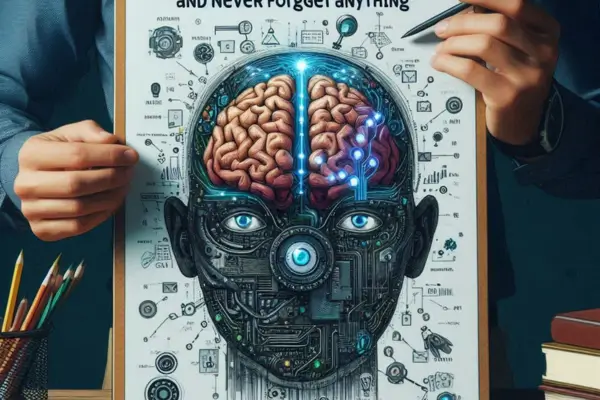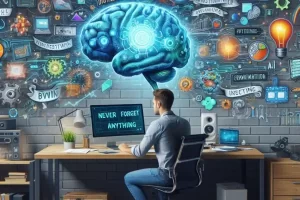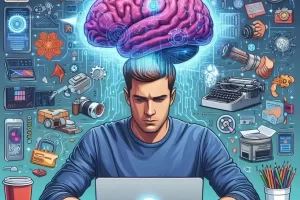Learning isn’t just about consuming content — it’s about retaining, applying, and evolving with what you’ve learned. But most people read books, take courses, or watch videos only to forget the key lessons weeks later. That’s where a second brain, enhanced with artificial intelligence (AI), can help you build a personal learning system that makes knowledge stick and grow with you.
In this article, you’ll learn how to create a learning system that captures ideas, connects concepts, and turns knowledge into real transformation — all inside your second brain.
Why You Need a Personal Learning System
Here’s what happens without one:
- You forget 90% of what you consume
- You keep rereading the same ideas
- You don’t apply what you learn
- You get overwhelmed by too many resources
- You don’t track progress or depth
With a second brain and AI, you can:
- Capture lessons from everything you read, watch, or experience
- Summarize and structure insights
- Make connections between disciplines
- Review and reflect systematically
- Apply new knowledge to your goals and projects
Define What You Want to Learn
Start by getting clear on why you’re learning and what you want to learn.
Define your learning focus:
- 🎯 Career skills (e.g., marketing, coding, leadership)
- 🧠 Mental models and decision-making
- 📚 Specific topics (e.g., productivity, psychology, design)
- 🧘 Personal growth or mindset
- 🧩 Cross-disciplinary knowledge (e.g., combining art and tech)
Let AI help:
“Based on my journal and projects, what learning areas should I focus on?”
“Create a 3-month learning plan based on my career goals.”
Now your learning becomes intentional, not random.
Set Up a Learning Hub in Your Second Brain
Create a space where all your learning lives. Your Learning Hub might include:
- 📖 Books
- 🎧 Podcasts
- 🎓 Courses
- 📄 Articles
- 🧠 Concepts & mental models
- 📌 Key takeaways and summaries
- ✅ Learning goals and progress
Each entry includes:
- Title
- Source
- Summary
- Application ideas
- Tags or categories
- Review date
Use AI to:
“Summarize this book in 5 key ideas.”
“Tag these 10 learning notes based on topic.”
“Link this podcast note to related concepts in my system.”
Capture Learning in Your Own Words
To learn deeply, you need to reprocess information, not just highlight it.
Use your second brain to:
- Write down the idea in your own words
- Add examples or metaphors
- Connect it to something you already know
- Note how or where you’ll use it
Let AI assist:
“Turn these highlights into a structured learning summary.”
“What are 3 ways I could apply this idea in my business or life?”
“What’s a good analogy to help me remember this concept?”
This step turns passive learning into active knowledge building.
Use Spaced Repetition and Smart Reviews
Reviewing is how you retain what you learn.
In your second brain:
- Set up weekly or monthly reviews
- Revisit older notes using spaced repetition
- Resurface forgotten insights at the right time
Let AI do the work:
“What lessons have I not reviewed in over 60 days?”
“Remind me of key concepts I captured last month.”
“Generate a quiz based on my recent notes.”
Now your second brain reminds you what you know, just when you need it.
Turn Knowledge Into Projects and Action
Learning becomes transformation when you apply it.
For each idea, ask:
- Where does this fit into my current goals?
- How can I teach or explain this to someone else?
- What’s one small experiment I can run with this insight?
Use AI to help:
“Turn this productivity tip into a 7-day experiment.”
“Help me create a presentation based on this book.”
“Suggest a content idea from this concept I just learned.”
This creates a loop: learn → apply → reflect → grow.
Track Progress and Evolution
Learning is a journey — treat it like one.
Track:
- Courses completed
- Books read
- Hours or sessions spent learning
- Topics mastered
- Shifts in mindset or approach
Ask AI:
“Summarize my learning activity this quarter.”
“What are the top 5 concepts I’ve focused on this year?”
“How has my thinking on [topic] evolved over time?”
Your second brain becomes a map of your intellectual growth.
Reflect and Evolve Your Learning Strategy
Periodically ask:
- Is what I’m learning still aligned with my goals?
- What am I consuming too much or too little of?
- What kind of knowledge excites me now?
Let AI support reflection:
“Based on my recent activity, what should I learn next?”
“What topics have I neglected lately?”
“Which ideas have been most impactful in my journal?”
Now your learning system adapts — just like you do.
Real-Life Example: The Lifelong Learner
Let’s say you’re a professional aiming to grow in marketing and leadership.
Your second brain includes:
- Learning hubs for each domain
- Summaries from books, podcasts, and videos
- Tags linking ideas across content
- Weekly AI-assisted reviews
- A content series you publish based on what you’ve learned
- Quarterly reflections to adjust your learning path
You’re not just learning more — you’re learning better, deeper, and with purpose.
Final Thoughts: Learn Deliberately, Remember Effortlessly
Information is everywhere. But transformation requires structure, focus, and reflection.
With a second brain and AI:
- You learn faster and remember more
- You organize insights as you go
- You apply what matters
- You grow intentionally — and sustainably
Don’t leave your learning to chance. Build a system that captures what you learn, connects it to your life, and makes it work for you.




